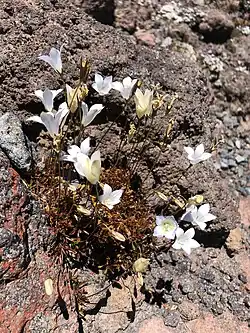Wahlenbergia pygmaea
| Wahlenbergia pygmaea | |
|---|---|

| |
| W. pygmaea near the Tongariro Crossing | |
| Scientific classification | |
| Kingdom: | Plantae |
| Clade: | Tracheophytes |
| Clade: | Angiosperms |
| Clade: | Eudicots |
| Clade: | Asterids |
| Order: | Asterales |
| Family: | Campanulaceae |
| Genus: | Wahlenbergia |
| Species: | W. pygmaea
|
| Binomial name | |
| Wahlenbergia pygmaea Colenso
| |
Wahlenbergia pygmaea, or North Island harebell,[2] is a species of flowering plant,endemic to New Zealand.[3][4] It is restricted to the North Island.[5]
Description
This species is a perennial, rhizomatous herb that has a dense cluster of leaves which are low to the ground, with white and blue flowers that extend from a short stem.[2] It has wider bell flowers than the similar congener W. albomarginata of the South Island.[6]
In the original description, William Colenso wrote:
This is a peculiarly striking little plant, from its uniform size and pleasing appearance, a rather large drooping bell-flower springing from its little squarrose moss-like tuft of leaves.[7]
The subspecies tararua can be distinguished by the rosettes of serrate, flat, dark-green leaves, while drucei has crimped, bright-green leaves.[6]
Range and habitat
Wahlenbergia pygmaea is restricted to the North Island, and has three disjunct populations which are accorded as subspecies: ssp. drucei near Taranaki, ssp. tararua in the Tararua Range, and ssp. pygmaea in the center of the island near on the central plateau near Tongariro.[5]
Wahlenbergia pygmaea grows above the treeline in montane and alpine environments. On the North Island, this is effectively limited to volcanoes and the central plateau, as well as the more southerly Tararuas. In the Rangipo desert, an arid region created by the eruption of Taupo Volcano, it can survive at lower elevations than elsewhere in the subalpine areas.[6] It can grow in tussock grassland or on rocky ground and old lava fields. At times it can be brought down by washes through riverbeds, where it can grow on stony ground.[2]
Ecology
The flowers are pollinated by insects.[2] The roots are associated with arbuscular mycorrhiza.[8] The species may be avoided by ungulates for food,[9] while another study of red deer and sika deer notes that they do eat the species.[10] The seeds have been stated to have been recovered from coprolites of various moa genera, which suggests that the extinct moa ate the plant[9] – however, the cited study looked at species from the South Island, which suggests these were plants in the Wahlenbergia albomarginata complex.[11]
Disturbance by vehicles appears to increase coverage of W. pygmaea compared to other species.[12]
Etymology
Wahlenbergia is named after Göran Wahlenberg. Pygmaea means 'tiny' in Latin.[2]
Drucei was named for the botanist A.P. "Tony" Druce of Wellington.[6]
Taxonomy
Wahlenbergia pygmaea contains the following subspecies:
- Wahlenbergia pygmaea subsp. tararua
- Wahlenbergia pygmaea subsp. drucei
- Wahlenbergia pygmaea subsp. pygmaea
Of these, pygmaea is Not Threatened,[13] while drucei is considered Range Restricted,[14] and tararua is Nationally Critical.[15]
The original description of the species was based on specimens gathered in the Ruahine range, which would possibly now be considered the subspecies tararua,[7] although not all authorities consider this a valid subspecies.[2][16]
Some taxonomists consider this species to be the same as W. albomarginata, from the South Island.[2] A study using amplified fragment length polymorphism could not distinguish the two species.[17]
References
- ^ "NZTCS". nztcs.org.nz. Retrieved 17 August 2025.
- ^ a b c d e f g "Wahlenbergia pygmaea subsp. pygmaea". New Zealand Plant Conservation Network. Retrieved 17 August 2025.
- ^ "Wahlenbergia pygmaea". iNaturalist. Retrieved 17 August 2025.
- ^ "Flora of New Zealand | Taxon Profile | Wahlenbergia pygmaea". www.nzflora.info. Retrieved 17 August 2025.
- ^ a b Petterson, Judith A. (March 1997). "Revision of the genus Wahlenbergia (Campanulaceae) in New Zealand". New Zealand Journal of Botany. 35 (1): 9–54. doi:10.1080/0028825X.1997.10410669. ISSN 0028-825X.
- ^ a b c d Petterson, J.A. (2005). "The genus Wahlenbergia,(Campanulaceae): the harebells of New Zealand" (PDF). Wellington Botanical Society Bulletin. 49.
- ^ a b Colenso, W (1898). "A Description of a few more Newly Discovered Indigenous Plants; being a Further Contribution towards the making known the Botany of New Zealand". Transactions and proceedings of the New Zealand Institute. 31. Wellington: New Zealand Institute.
- ^ Moyle, Darby. Impact of Climate Warming and Plant Invasion on the Soil Microbial Community in Alpine Zones (Thesis). Victoria University of Wellington Library.
- ^ a b Lee, William G.; Wood, Jamie R.; Rogers, Geoffrey M. (4 November 2009). "Legacy of avian-dominated plant–herbivore systems in New Zealand". New Zealand Journal of Ecology. 34 (1): 28–47.
- ^ Forsyth, D. M.; Coomes, D. A.; Nugent, G.; Hall, G. M. J. (January 2002). "Diet and diet preferences of introduced ungulates (Order: Artiodactyla) in New Zealand". New Zealand Journal of Zoology. 29 (4): 323–343. doi:10.1080/03014223.2002.9518316. ISSN 0301-4223.
- ^ Wood, Jamie R.; Rawlence, Nicolas J.; Rogers, Geoffery M.; Austin, Jeremy J.; Worthy, Trevor H.; Cooper, Alan (1 December 2008). "Coprolite deposits reveal the diet and ecology of the extinct New Zealand megaherbivore moa (Aves, Dinornithiformes)". Quaternary Science Reviews. Ice Age Refugia and Quaternary Extinctions: An Issue of Quaternary Evolutionary Palaeoecology. 27 (27): 2593–2602. doi:10.1016/j.quascirev.2008.09.019. ISSN 0277-3791.
- ^ Smith, Angelina Robyn (2014). Vehicle damage to vegetation of the Rangipo Desert, Tongariro National Park, New Zealand [Unpublished thesis]. Massey University.
- ^ "NZTCS". nztcs.org.nz. Retrieved 17 August 2025.
- ^ "NZTCS". nztcs.org.nz. Retrieved 17 August 2025.
- ^ "NZTCS". nztcs.org.nz. Retrieved 17 August 2025.
- ^ "Flora of New Zealand | Taxon Profile | Wahlenbergia pygmaea". www.nzflora.info. Retrieved 17 August 2025.
- ^ Prebble, JM; Meudt, HM; Garnock-Jones, PJ (1 September 2012). "Phylogenetic relationships and species delimitation of New Zealand bluebells (Wahlenbergia, Campanulaceae) based on analyses of AFLP data". New Zealand Journal of Botany. 50 (3): 365–378. doi:10.1080/0028825X.2012.698624. ISSN 0028-825X.
